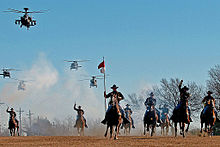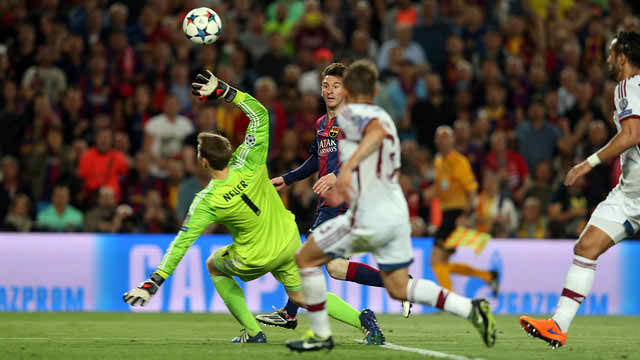U.S. ARMY
The United States Army (USA) is the largest branch of the United States Armed Forces and performs land-based military operations. It is one of the seven uniformed services of the United States, and is designated as the Army of the United States in the United States Constitution, Article 2, Section 2, Clause 1 and United States Code, Title 10, Subtitle B, Chapter 301, Section 3001. As the largest and senior branch of the U.S. military, the modern U.S. Army has its roots in the Continental Army, which was formed (14 June 1775) to fight the American Revolutionary War (1775–83)—before the U.S. was established as a country.[6] After the Revolutionary War, the Congress of the Confederation created the United States Army on 3 June 1784, to replace the disbanded Continental Army.[7][8] The United States Army considers itself descended from the Continental Army, and dates its institutional inception from the origin of that armed force in 1775.[6]
As a uniformed military service, the Army is part of the Department of the Army, which is one of the three military departments of the Department of Defense. The U.S. Army is headed by a civilian senior appointed civil servant, the Secretary of the Army (SECARMY), and by a chief military officer, the Chief of Staff of the Army (CSA) who is also a member of the Joint Chiefs of Staff. In the fiscal year 2011, the reported strengths for the Regular Army (USA) was 546,057 soldiers; the Army National Guard (ARNG) had 358,078 soldiers, and the United States Army Reserve (USAR) had 201,166 soldiers; the combined-component strength of the U.S. Army was 1,105,301 soldiers.[3] As a branch of the armed forces, the mission of the U.S. Army is "to fight and win our Nation's wars, by providing prompt, sustained, land dominance, across the full range of military operations and the spectrum of conflict, in support of combatant commanders."[9]
Mission
The United States Army serves as the land-based branch of the U.S. Armed Forces. Section 3062 of Title 10 US Code defines the purpose of the army as:[10][11]- Preserving the peace and security and providing for the defense of the United States, the Commonwealths and possessions and any areas occupied by the United States
- Supporting the national policies
- Implementing the national objectives
- Overcoming any nations responsible for aggressive acts that imperil the peace and security of the United States
History
The Continental Army was created on 14 June 1775 by the Continental Congress[12] as a unified army for the colonies to fight Great Britain, with George Washington appointed as its commander.[6][13][14][15] The army was initially led by men who had served in the British Army or colonial militias and who brought much of British military heritage with them. As the Revolutionary War progressed, French aid, resources, and military thinking influenced the new army. A number of European soldiers came on their own to help, such as Friedrich Wilhelm von Steuben, who taught the army Prussian tactics and organizational skills.
The army fought numerous pitched battles and in the South 1780–81 sometimes used the Fabian strategy and hit-and-run tactics, hitting where the enemy was weakest, to wear down the British forces. Washington led victories against the British at Trenton and Princeton, but lost a series of battles around New York City in 1776 and Philadelphia in 1777. With a decisive victory at Yorktown, and the help of the French, the Continental Army prevailed against the British.
After the war, though, the Continental Army was quickly given land certificates and disbanded in a reflection of the republican distrust of standing armies. State militias became the new nation's sole ground army, with the exception of a regiment to guard the Western Frontier and one battery of artillery guarding West Point's arsenal. However, because of continuing conflict with Native Americans, it was soon realized that it was necessary to field a trained standing army. The Regular Army was at first very small, and after General St. Clair's defeat at the Battle of the Wabash, the Regular Army was reorganized as the Legion of the United States, which was established in 1791 and renamed the "United States Army" in 1796.
Structure
The United States Army is made up of three components: the active component, the Regular Army; and two reserve components, the Army National Guard and the Army Reserve. Both reserve components are primarily composed of part-time soldiers who train once a month, known as battle assemblies or unit training assemblies (UTAs), and conduct two to three weeks of annual training each year. Both the Regular Army and the Army Reserve are organized under Title 10 of the United States Code, while the National Guard is organized under Title 32. While the Army National Guard is organized, trained and equipped as a component of the U.S. Army, when it is not in federal service it is under the command of individual state and territorial governors; the District of Columbia National Guard, however, reports to the U.S. President, not the district's mayor, even when not federalized. Any or all of the National Guard can be federalized by presidential order and against the governor's wishes.[53]
The army is led by a civilian Secretary of the Army, who has the statutory authority to conduct all the affairs of the army under the authority, direction and control of the Secretary of Defense.[54] The Chief of Staff of the Army, who is the highest-ranked military officer in the army, serves as the principal military adviser and executive agent for the Secretary of the Army, i.e., its service chief; and as a member of the Joint Chiefs of Staff, a body composed of the service chiefs from each of the four military services belonging to the Department of Defense who advise the President of the United States, the Secretary of Defense, and the National Security Council on operational military matters, under the guidance of the Chairman and Vice Chairman of the Joint Chiefs of Staff.[55][56] In 1986, the Goldwater–Nichols Act mandated that operational control of the services follows a chain of command from the President to the Secretary of Defense directly to the unified combatant commanders, who have control of all armed forces units in their geographic or function area of responsibility. Thus, the secretaries of the military departments (and their respective service chiefs underneath them) only have the responsibility to organize, train and equip their service components. The army provides trained forces to the combatant commanders for use as directed by the Secretary of Defense.[57]
Through 2013, the army is shifting to six geographical commands that will line up with the six geographical unified combatant commands (COCOM):The 1st Cavalry Division's combat aviation brigade performs a mock charge with the horse detachment
- United States Army Central headquartered at Shaw Air Force Base, South Carolina
- United States Army North headquartered at Fort Sam Houston, Texas
- United States Army South headquartered at Fort Sam Houston, Texas
- United States Army Europe headquartered at Clay Kaserne, Wiesbaden, Germany
- United States Army Pacific headquartered at Fort Shafter, Hawaii
- United States Army Africa headquartered at Vicenza, Italy
U.S. Army Special Forces soldiers from the 3rd Special Forces Group patrol a field in the Gulistan district of Farah, Afghanistan
- Armor brigade, with strength of 4,743 troops as of 2014.
- Stryker brigades, with strength of 4,500 troops as of 2014.
- Infantry brigades, with strength of 4,413 troops as of 2014.
source:wikipedia
TO KNOW MORE











